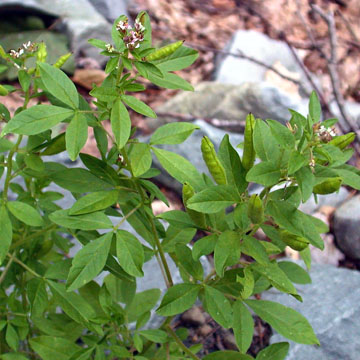

Polanisia dodecandra - (image 1 of 4)
Taxonomy
Family: Cleomaceae
Habitat
Sandy or gravelly areas, often along streams but also disturbed uplands habitats.
Associates
Distribution
NH and southern Quebec to Alberta and WA, south to MD, TN, AR, TX, and NM.
Morphology
Annual; stems 20-60+ cm; petiolate about as long as the blades; leaves opposite, trifoliate; leaflets ovate or obovate to lance-elliptic, 1.5-6+ cm long and 0.5-2 cm wide; flowers numerous (15-30); bracts simple; petals white to pink, irregularly truncate to deeply emarginated; stamens (7-)10-27; nectary solid, 1-2 mm long and 0.5-1.5 mm wide, with bright orange or orange red summit, inconspicuous in fruit; style 3-40 mm, slender, withering and deciduous in fruit; fruits oblong to narrowly fusiform, flattened but somewhat inflated, mostly 3-6 cm long and 5-10 mm wide, on a stipe 2-6 mm long, the valves separating apically for 1/3 to 2/3 of their length; seeds mostly 15-40+, 1.7-3 mm long.
Notes
Flowers July to September
Wetland indicator: UPL
The plants pictured here are ssp. dodecandra with petals 3.5-6.5(-8) mm and stamens 4-10(-14) mm; ssp. trachysperma (Torr. & A. Gray) Iltis is more western (to MN and MO, occasionally introduced eastward) and has larger petals (7-16 mm) and stamens (9-30 mm).
References
Gleason, Henry A. and A. Cronquist. 1991. Manual of Vascular Plants of Northeastern United States and Adjacent Canada. Second Ed.
The New York Botanical Garden. Bronx, NY
USDA, NRCS. 2002. The PLANTS Database, Version 3.5 (http://plants.usda.gov).
National Plant Data Center, Baton Rouge, LA 70874-4490 USA.
|
Michael Hough © 2018 |